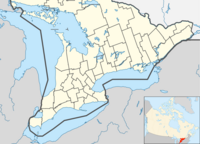Chippewas of the Thames First Nation
| Chippewas of the Thames First Nation 42 | |
|---|---|
| Indian reserve | |
| Chippewas of the Thames First Nation Indian Reserve No. 42 | |
| Coordinates: 42°50′N 81°29′W / 42.833°N 81.483°WCoordinates: 42°50′N 81°29′W / 42.833°N 81.483°W | |
| Country |
|
| Province |
|
| County | Middlesex |
| First Nation | Chippewas of the Thames |
| Formed | 1819 |
| Government | |
| • Chief | Henry, Myeengun |
| • Federal riding | Lambton—Kent—Middlesex |
| • Prov. riding | Lambton—Kent—Middlesex |
| Area | |
| • Land | 39.11 km2 (15.10 sq mi) |
| Population (2011) | |
| • Total | 762 |
| • Density | 19.5/km2 (51/sq mi) |
| Time zone | EST (UTC-5) |
| • Summer (DST) | EDT (UTC-4) |
| Postal Code | N0L |
| Area code(s) | 519 and 226 |
| Website | www.cottfn.com |
Chippewas of the Thames First Nation is an Anishinaabe (Ojibway) First Nations band government located 24 kilometres (15 mi) west of St. Thomas, in southwest Ontario, Canada. Their land base is the 3,652.60 hectares (9,025.8 acres) Chippewas of the Thames First Nation 42 reserve, which almost entirely surrounds the separate reserve of Munsee-Delaware 1. As of January 2014, their registered population is 2,738 people with 957 living on reserve.
In 1763, Chief Seckas of the Thames River brought 170 warriors to the siege of Detroit during Pontiac's uprising. The reserve was established in 1819, as part of a treaty by which the Chippewas of the Thames agreed to share 552,000 acres (2,234 km²) of land with the British for an annuity of £600 and the establishment of two reserves, of which reserve no. 42 is the larger. In 1840 the Chippewas reached an agreement with the Munsee-Delaware Nation to the allow the Munsee to live on 1 square mile near the Thames river. The Munsee portion of the reserve became part of the new Munsee-Delaware Nation No. 1 reserve in 1967.
After the Chippewas of the Thames community filed suit against Enbridge to stop its controversial pipeline through Chippewas land, in July 2017, the Supreme Court of Canada ordered the community of 3,000 to pay Enbridge’s legal costs.
Chippewas of the Thames First Nation's Chief and Council are elected officials who serve 2 year terms of office. The current elected officials are Chief Myeengun (Arnold "Allan") Henry, and Councillors Denise Beeswax, Michelle Burch, Kodi Chrisjohn, Beverly Deleary, Raymond Deleary, Jacqueline French, Larry French, Rawleigh Grosbeck, Carolyn Henry, Myeengun Henry, Warren Huff, Leland Sturgeon and Darlene Whitecalf. Their terms of office expire on July 27, 2018.
In 2015, Leslee White-Eye (née Henry) was the first elected woman chief of Chippewas of the Thames First Nation. She follows Arletta Silver (née Riley) in 1953 and Starr McGahey-Albert (20xx) who were appointed the role of chief due to the elected Chief of the day being unable to fulfill his duties i.e., illness. Leslee White-Eye is the daughter of George E. Henry and Theresa E. Henry (née Deleary) both Chippewas of the Thames First Nation members. During her term she was able to finalize the community benefit agreement amendments with the City of Toronto over the Greenlane Landfill site resulting in monies held in trust since 2009 to be released in December 2016 to the Chippewas of the Thames First Nation community for their benefit. Also during her tenure, Chief White-Eye sought nation attention in the community's Supreme Court case Chippewas of the Thames First Nation vs. Enbridge et al. She was able to garner full support from Chiefs-in-Assembly resolutions from the Anishinaabek Nation/Union of Ontario Indians, Chiefs of Ontario and Assembly of First Nations to proceed with a leave to appeal to the Supreme Court. In response, to the ongoing legal proceedings Chipppewas of the Thames approved the nation's Duty to Consult Protocol, Wiindamaagwein, in 2016 which outlines the expectations the nation has regarding proponent and government relations with the nation. In addition, Chief White-Eye led the political work behind the signing of an Agreement-in-Principle with the Province of Ontario on July 20, 2017 in tobacco self-regulation on-reserve in July 2017. The self-regulatory work situates the tobacco sector on-reserve as a legitimate economic sector worthy of legislative frameworks to make it so. This is in direct opposition to the federal government's response to on-reserve un-marked tobacco sales as 'contraband' and making it a criminal act as of 2015. On July 13, 2017, Chief White-Eye was awarded an honorary Doctor of Laws, honoris causa (LLD)] at Western University as an emerging leader in the region, particularly for her work to improve municipal-nation relations with the City of London.
...
Wikipedia

